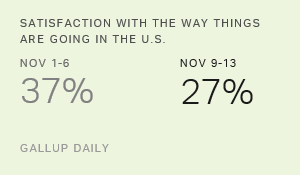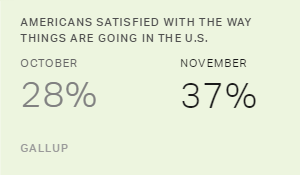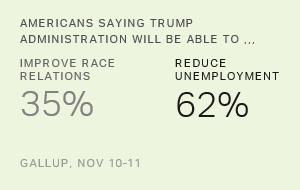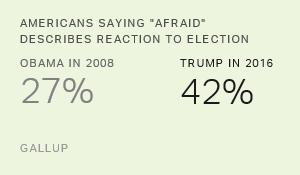Story Highlights
- Satisfaction dropped from 37% to 27% just after election
- Rate dropped back below historical average of 37%
- Among Democrats, rate fell almost 30 percentage points after election�ċ
WASHINGTON, D.C. -- Americans' satisfaction with the way things are going in the U.S. plunged 10 percentage points in the aftermath of the presidential election -- retreating from a in the run-up to last Tuesday's vote. The 27% of Americans who are satisfied matches the 2016 average so far but is 10 points below the historical average for the more than 300 times ���۴�ýhas asked the question since 1979.
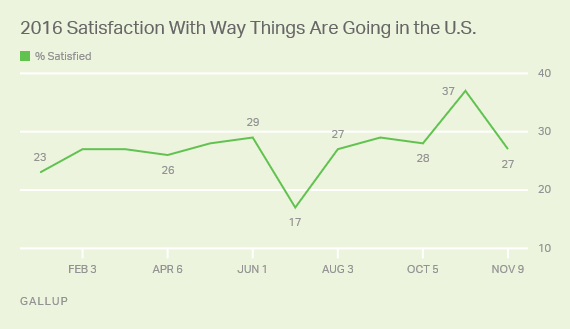
A sharp decline in satisfaction among Democrats explains most of the drop. Before the election, 62% of Democrats were satisfied; now, 34% are. Widespread forecasts that Democratic nominee Hillary Clinton would win gave Democrats' outlook a boost in the week before the election. The increase among Democrats from 49% in October to 62% in the days leading up to the election was more than erased after Clinton lost.
Republicans' attitudes were much less volatile over the past two months. The satisfaction rate rose slightly from 8% in October to 14% just before the election, and then climbed a few more points to 17% after Republican Donald Trump's victory.
| All adults | Republicans | Independents | Democrats | ||||||||||||||||||||||||||||||||||||||||||||||||||||||||||||||||||||||||||||||||||||||||||||||||
|---|---|---|---|---|---|---|---|---|---|---|---|---|---|---|---|---|---|---|---|---|---|---|---|---|---|---|---|---|---|---|---|---|---|---|---|---|---|---|---|---|---|---|---|---|---|---|---|---|---|---|---|---|---|---|---|---|---|---|---|---|---|---|---|---|---|---|---|---|---|---|---|---|---|---|---|---|---|---|---|---|---|---|---|---|---|---|---|---|---|---|---|---|---|---|---|---|---|---|---|
| % | % | % | % | ||||||||||||||||||||||||||||||||||||||||||||||||||||||||||||||||||||||||||||||||||||||||||||||||
| Oct 5-9 | 28 | 8 | 24 | 49 | |||||||||||||||||||||||||||||||||||||||||||||||||||||||||||||||||||||||||||||||||||||||||||||||
| Nov 1-6 | 37 | 14 | 34 | 62 | |||||||||||||||||||||||||||||||||||||||||||||||||||||||||||||||||||||||||||||||||||||||||||||||
| Nov 9-13 | 27 | 17 | 27 | 34 | |||||||||||||||||||||||||||||||||||||||||||||||||||||||||||||||||||||||||||||||||||||||||||||||
| Gallup | |||||||||||||||||||||||||||||||||||||||||||||||||||||||||||||||||||||||||||||||||||||||||||||||||||
Though the percentage of Republicans saying they are satisfied with the way things are going rose only three points after the election, the 17% is still the highest satisfaction rate among Republicans since President Barack Obama first took office in January 2009. Democrats' current satisfaction level is slightly below their 39% average for Obama's time in office and 10 points below their 44% average for 2016.
Satisfaction levels followed a similar pattern after the White House changed parties in 2008. In the days following that election, satisfaction dropped more among Republicans (26% to 19%) than it rose among Democrats (4% to 7%). The real increase among Democrats came right after Obama's inauguration in January (rising to 22%) and in the first months of his presidency, reaching 50% in May.
Obama Years Marked by Low Satisfaction Rates
Obama, who was elected as the U.S. reeled from a series of economic shocks, has seen an increase in the average satisfaction rate, from 15% in the year before he took office to 27% this year. Over the nearly eight years of his presidency, the satisfaction rate has averaged 24%, the lowest average for any president's term of office since Ronald Reagan was inaugurated in 1980.
Bottom Line
Democrats, buoyed in early November by the consensus among political pundits and pollsters that they would retain the White House, now have a much bleaker outlook as they survey the national landscape. Among Republicans and independents, strong majorities were not satisfied with the way things were going in the U.S. before the election, and that is still the case.
Americans' satisfaction with the state of the nation showed little or no improvement in the first days after the inauguration of the last three presidents, though the rate did eventually rise in the early months of the Obama and Bill Clinton administrations. It is unlikely that the inauguration of Trump, who has been more unpopular than any of the past three presidents when they ran for office, will produce an immediate major increase in the number of Americans who are satisfied with the way things are going. However, if the majority of Americans are right in their belief that Trump will , his presidency could be marked by a major change in the satisfaction rate.
Survey Methodology
Results for this ���۴�ýpoll are based on telephone interviews conducted Nov. 9-13, 2016, with a random sample of 1,019 adults, aged 18 and older, living in all 50 U.S. states and the District of Columbia. For results based on the total sample of national adults, the margin of sampling error is ±4 percentage points at the 95% confidence level. All reported margins of sampling error include computed design effects for weighting.
Each sample of national adults includes a minimum quota of 60% cellphone respondents and 40% landline respondents, with additional minimum quotas by time zone within region. Landline and cellular telephone numbers are selected using random-digit-dial methods.
View survey methodology, complete question responses and trends.
Learn more about how the works.
